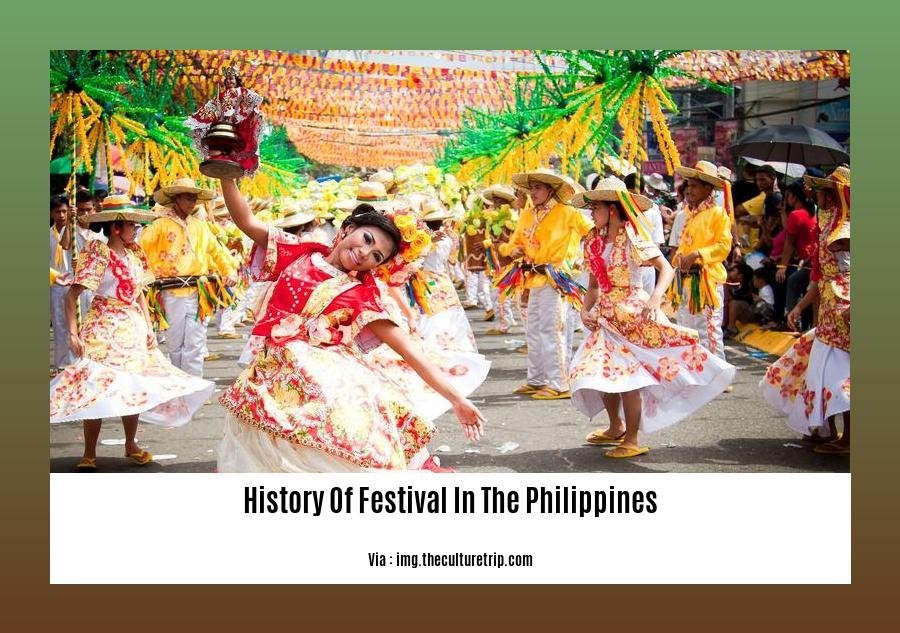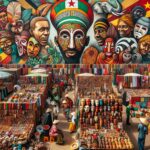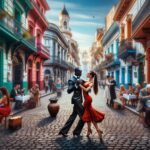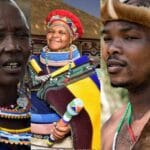Picture this: a kaleidoscope of colors, the beat of lively dances, and a captivating spectacle of rituals. That’s the Philippines for you! Our festivals aren’t just parties; they’re like magic carpets that take us back in time to learn about our roots. They’re a beautiful tapestry that connects our past to the amazing country we are today.
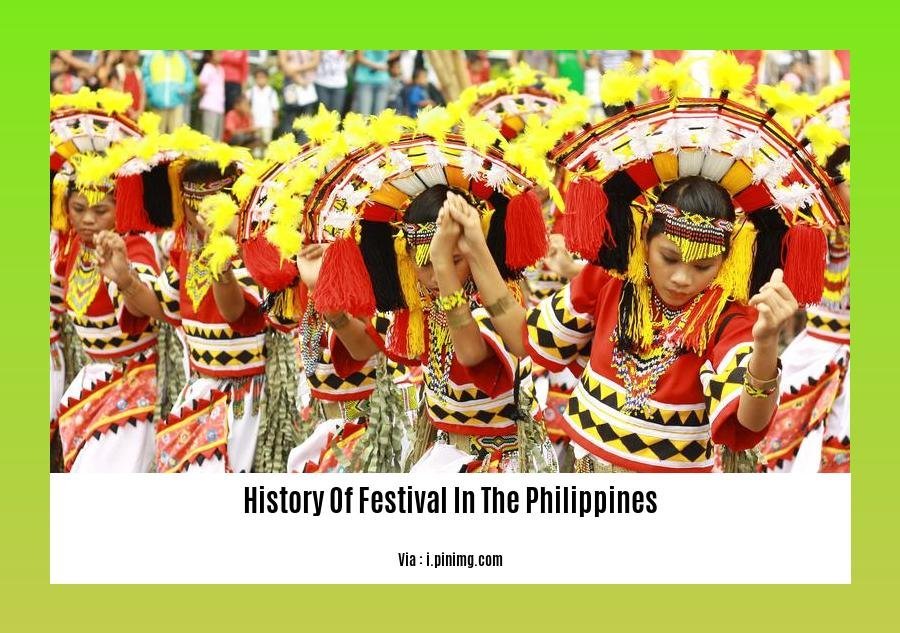
History of Festivals in the Philippines
From Ancient Roots to Modern Celebrations
Long before the Philippines we know today, Filipinos were already celebrating. These early fiestas were deeply rooted in animist beliefs, honoring spirits and nature. When the Spanish arrived and brought Catholicism, these ancient traditions didn’t disappear. Instead, they blended with the new religion, creating a unique mix of the old and the new. Patron saints were embraced, adding another layer to the vibrant tapestry of celebrations.
Fast forward to today, and you’ll see how Philippine festivals still carry echoes of the past while embracing the present. They’re a testament to the country’s ability to adapt and evolve, seamlessly weaving modern elements into centuries-old traditions.
More Than Just Fun and Games
Philippine festivals are a vibrant expression of what it means to be Filipino. They’re not just about colorful costumes and lively music; they’re about preserving traditions, sharing stories, and strengthening the bonds of community.
These celebrations offer a window into the Filipino soul, showcasing:
- Values and Beliefs: From the importance of family and community to the deep respect for elders and ancestors, these values come alive during festivals.
- Artistic Heritage: Traditional dances, music, crafts – festivals are a living museum of Filipino artistry, passed down through generations.
- Unity and Belonging: Festivals bring people together, fostering a strong sense of community and shared identity.
Faith and Celebration Intertwined
Religion is a cornerstone of Filipino culture, and it shines brightly during festivals. Many celebrations revolve around honoring patron saints or commemorating important events in the Catholic calendar.
Imagine:
- Processions: Statues of saints, adorned with flowers and lights, paraded through the streets, accompanied by devotees singing hymns.
- Rituals and Offerings: From lighting candles to offering food, these acts demonstrate faith and devotion.
- Festive Atmosphere: The solemnity of religious observances blends seamlessly with the joyous spirit of celebration, creating a unique atmosphere.
A Kaleidoscope of Festivals
The Philippines is a country of diverse cultures and traditions, reflected in the sheer variety of its festivals. Here’s a glimpse:
| Type of Festival | Description | Examples |
|---|---|---|
| Religious Festivals | Pay homage to patron saints or mark religious events | Sinulog Festival (Cebu), Ati-Atihan Festival (Kalibo), Pahiyas Festival (Lucban) |
| Cultural Festivals | Showcase indigenous arts, customs, and traditions | Panagbenga Flower Festival (Baguio), Kadayawan Festival (Davao), Moriones Festival (Marinduque) |
| Historical Festivals | Commemorate significant historical events | Kastilyo Festival (Aklan), Higyaw Festival (Bohol) |
| Food Festivals | Celebrate the richness of local and regional cuisine | Parada ng Lechon (Balangas), Mango Festival (Guimaras) |
| Music & Arts Festivals | Showcase various forms of artistic talent and creativity | Fete de la Musique, Dinagyang Festival (Iloilo) |
Unveiling Hidden Depths
Beyond the surface of vibrant colors and infectious energy lies a deeper story. Exploring the pre-colonial roots of these festivals and understanding how they’ve adapted to modern influences reveal a rich tapestry of cultural heritage. It’s fascinating to trace the evolution – seeing how ancient rituals have intertwined with Spanish influences and how today’s festivals incorporate technology and new artistic expressions.
More than just celebrations, festivals are vital for:
- Tourism: Attracting visitors from all corners of the globe, showcasing the unique beauty of Philippine culture.
- Cultural Preservation: Keeping traditions alive for future generations, ensuring they aren’t lost in the sands of time.
- Economic Growth: Boosting local economies, creating jobs, and fostering community development.
So, when you experience a Philippine festival, remember that you’re witnessing more than just a celebration – you’re witnessing history, faith, and the indomitable spirit of the Filipino people.
Learn about the history of the Philippines’ renowned martial arts, such as Kali, Eskrima, and Arnis, with insightful details that will intrigue any martial arts enthusiast. history of filipino martial arts
In this fascinating tale, explore the origins of Florida Water, a famous cologne with a captivating history, and discover its unique properties and enduring legacy in the Philippines. history of florida water
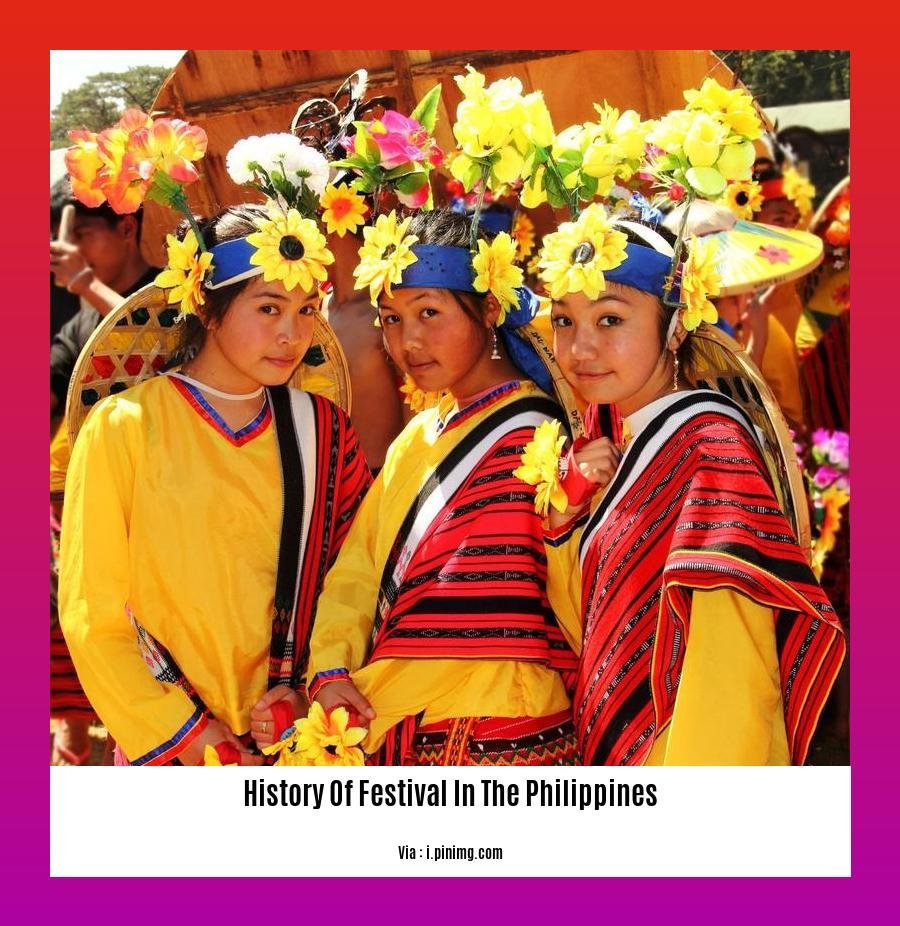
How Did Spanish Colonization Influence Philippine Festivals?
Spanish colonization profoundly shaped Filipino culture, language, and societal fabric, leaving an enduring legacy evident in various aspects of Philippine life. One of the most notable impacts can be seen in the evolution of Philippine festivals.
Catholicism, introduced by Spanish colonizers, became the dominant religion in the Philippines, deeply influencing Filipino beliefs, values, and traditions. This religious shift is clearly visible in the numerous festivals that honor patron saints or commemorate significant events within the Catholic calendar.
The fusion of indigenous practices and Catholic beliefs resulted in a unique blend of religious syncretism. For example, “Simbang Gabi,” the beloved Christmas Eve Mass, beautifully combines Catholic tradition with that special Filipino warmth. Similarly, “Sinulog,” the “Feast of the Child Jesus,” sees ancient beliefs intertwine with Catholic practices in a massive celebration of faith.
Beyond religious observances, the Spanish language itself has left an indelible mark on Philippine festivals. Many festival names, such as “Pahiyas,” the Thanksgiving festival, and “Moriones,” a unique Passion play, are derived from Spanish. This linguistic legacy reflects the deep intertwining of the two cultures over centuries.
The influence of Spanish culture is also evident in the music and dance forms prevalent in many festivals. The infectious rhythms of festival music often echo Spanish melodies, showcasing a direct link to the colonial era. “Flores de Mayo,” a Maytime procession honoring the Virgin Mary, is a prime example. As participants sway to the melodies and perform graceful dances, they are experiencing a living connection to the Philippines’ Spanish colonial past.
What Makes Philippine Festival Costumes So Special?
Key Takeaways:
- Philippine festival costumes unveil the country’s rich cultural heritage and traditions.
- They embody the creativity and artistry of Filipino artisans and craftspeople.
- Costumes vary significantly across festivals, reflecting the diversity of Philippine culture.
- They often incorporate indigenous materials, intricate designs, and vibrant colors.
- Festival costumes contribute to the overall festive atmosphere and create a sense of communal identity.
Philippine festival costumes go beyond mere attire; they are vibrant, living expressions of Filipino history and culture. In a riot of color, music, and dance, these costumes stand as a testament to the artistry and skills passed down through generations of Filipino artisans. They represent a fascinating blend of ancient customs with influences from Spain, China, and America, reflecting the country’s diverse cultural melting pot.
Each festival costume tells its own unique story. Take the Ati-Atihan Festival in Kalibo, Aklan. Dancers adorned in costumes crafted from natural elements like leaves and flowers embody the festival’s ancient roots and emphasize the importance of nature. Every detail, from the materials used to the vibrant colors, carries deeper meaning, often tied to local legends, folklore, or beliefs.
Just like the islands themselves, festival costumes display incredible diversity. The Cordillera region boasts vibrant highland costumes, while the Maranao people of Mindanao captivate onlookers with their elaborate gowns. Each region adds its own unique flavor and flair, transforming every festival into a visual feast and a unique cultural experience.
Behind these stunning creations are the unsung heroes – the skilled artisans and craftspeople. These cultural guardians meticulously employ techniques passed down through generations to create masterpieces that bring the festivals to life. Their dedication and artistry are evident in every stitch and embellishment, transforming simple materials into extraordinary works of art that embody the soul of the Philippines.
Music: The Heartbeat of Philippine Festivals
Music is the lifeblood of Philippine festivals, infusing them with an irresistible energy that transcends differences and unites people in a symphony of shared rhythm. Imagine a blend of ancient instruments and modern beats, a sonic tapestry woven from the historical and cultural threads of the Philippines.
Since the dawn of time, indigenous communities have used music to communicate with their gods, celebrate victories, and commemorate important events. That deep connection between music and culture pulses vibrantly in the Philippines today. Add in the influence of Spanish musical traditions from the 16th century, and you have a unique soundscape that is both familiar and exotic.
Music plays a central role in the many festivals steeped in Catholic tradition. Grand processions are accompanied by hymns and devotional songs, creating an atmosphere of reverence and celebration. Lively folk dances, each with their own distinctive musical groove, add another layer of sensory richness to the festivities. For festivals not tied to religion, the music takes on a more playful, celebratory tone. Upbeat melodies and infectious rhythms encourage everyone to join in, dance, and embrace the joyous atmosphere.
The true magic of Philippine festival music lies in its incredible diversity of instruments. Traditional instruments like the kulintang, a set of hanging gongs that resonate with history, and the gabbang, a bamboo xylophone that adds a playful clatter, provide a foundation upon which modern instruments like guitars, drums, and keyboards build, creating a soundscape that bridges past and present.
Here’s the takeaway:
- Music isn’t just an addition to Philippine festivals, it’s the glue that holds everything together, connecting generations through shared rhythms.
- Imagine a musical melting pot where indigenous beats meet Spanish melodies – that’s the soundtrack of Filipino celebrations.
- Religious festivals blend solemn hymns and joyful dances, each with its own musical personality.
- Non-religious festivals are all about letting loose, with music designed to get everyone moving and grooving.
- From ancient gongs to modern electric guitars, Philippine festivals are a sonic adventure, showcasing the country’s diverse musical heritage.
Key Points:
- Historical Roots: Philippine festivals have evolved from ancient animist beliefs to incorporate Spanish Catholic influences.
- Vibrant Expressions: Festivals preserve traditions, showcase cultural heritage, and strengthen community bonds.
- Values and Beliefs: Festivals reflect Filipino values such as respect for elders and the importance of family.
- Artistic Heritage: They feature traditional dances, music, and crafts, passing down artistry across generations.
- Religious Intertwinement: Many festivals revolve around patron saints or religious events, featuring processions, rituals, and a festive atmosphere.
- Kaleidoscope of Festivals: The Philippines boasts a diverse range of festivals, including religious, cultural, historical, food, and music & arts.
- Hidden Depths: Festivals reveal a deeper story of cultural heritage, adaptation, and evolution.
- Vital Roles: Festivals contribute to tourism, cultural preservation, and economic growth.
- Crypto Quotes’ Red Flags: Avoid Costly Mistakes - June 30, 2025
- Unlock Inspirational Crypto Quotes: Future Predictions - June 30, 2025
- Famous Bitcoin Quotes: A Deep Dive into Crypto’s History - June 30, 2025
